
| Castlemaine | 82 Miles 50 Chains 01 Links / 132.972 km | Ravenswood |
| (Barkers Creek) |
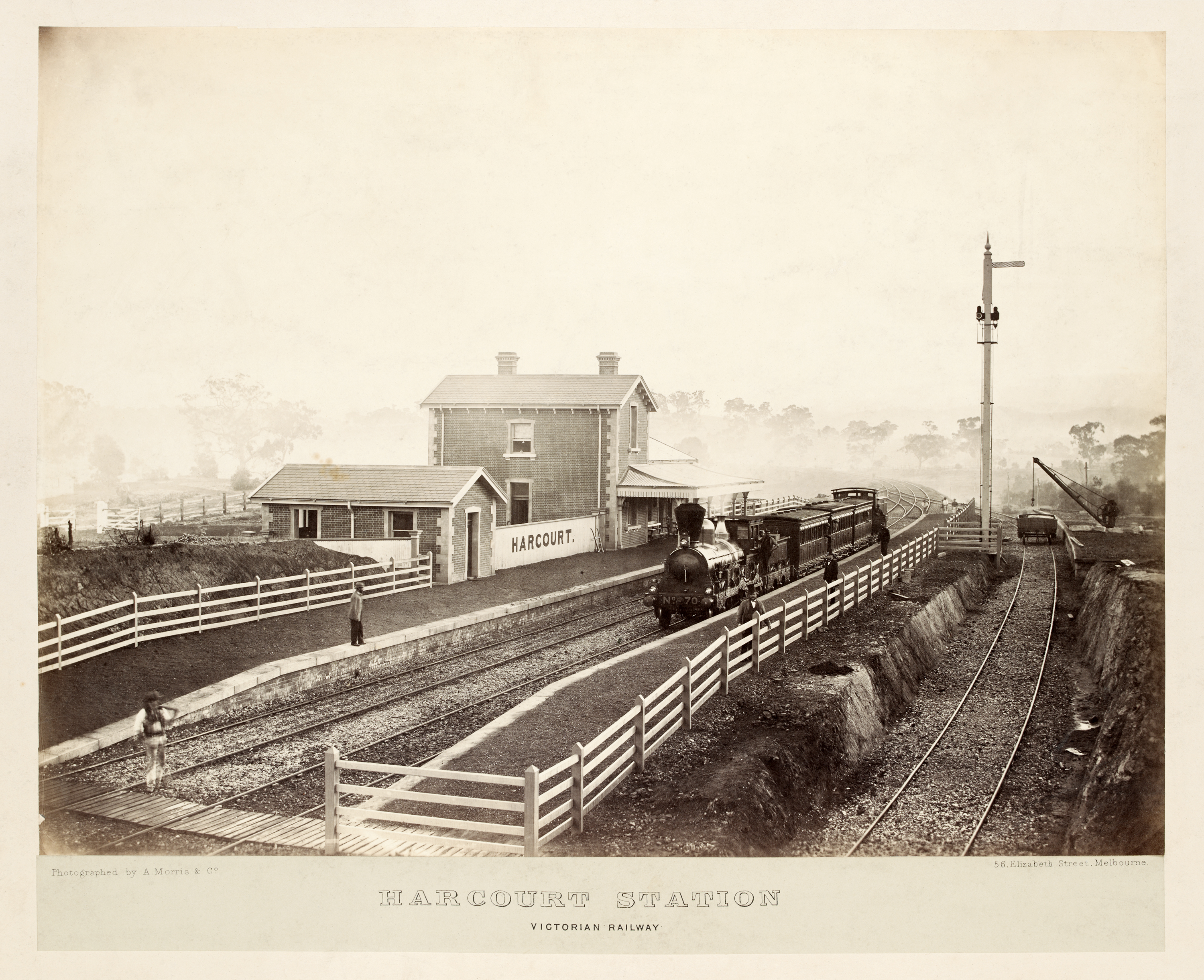
ABOVE: One of my favourite early VR photos is this often reproduced classic taken at Harcourt circa 1870. It shows the up Bendigo to Melbourne passenger train standing at the platform. There are very few photos that were taken earlier than this of the VR. The locomotive "No 70" was a 2-4-0 built by Beyer Peacock in 1864 which would later be known as the "B class" at the time they would have been the standard passenger loco on the Bendigo line. At this time Westinghouse air brakes were far in the future and the only brakes were the tender brake and the guards van brake, (hence the name "brakevan") both operating wooden brake blocks. Considering that the maximum speed was 60 mph the crew would have really had to know the track profile in order to operate the train safely. Perhaps the most significant feature in the photo is the slotted arm semaphore signal. At the time the Bendigo track was operated under the "time interval" system. An up and down arm were provided on the post and as can be seen here, the train has arrived so the Porter has put the up signal to the danger position, arm horizontal (red light at night). After 5 minutes had elapsed since the trains departure the arm would be lowered to 45 degrees below horizontal, (green light at night) called the caution position. After 10 minutes had elapsed since the trains departure the arm could be placed at to the "all right" position at which time the arm disappeared into the slot in the post, (white light at night) Amazingly this seqence of lights is still in use today with the handlamp signals given during night shunting. Finally, the ramped platform ends were a feature of Victorian stations until the reign of Thomas Tait (1903 - 1910) which saw practically every platform have the now familiar vertical end with fence to deter the rascally fare evaders.
The view from the same vantage point BELOW, was taken in October 2008, approx 138 years later!
(Photo courtesy Chris Wurr)
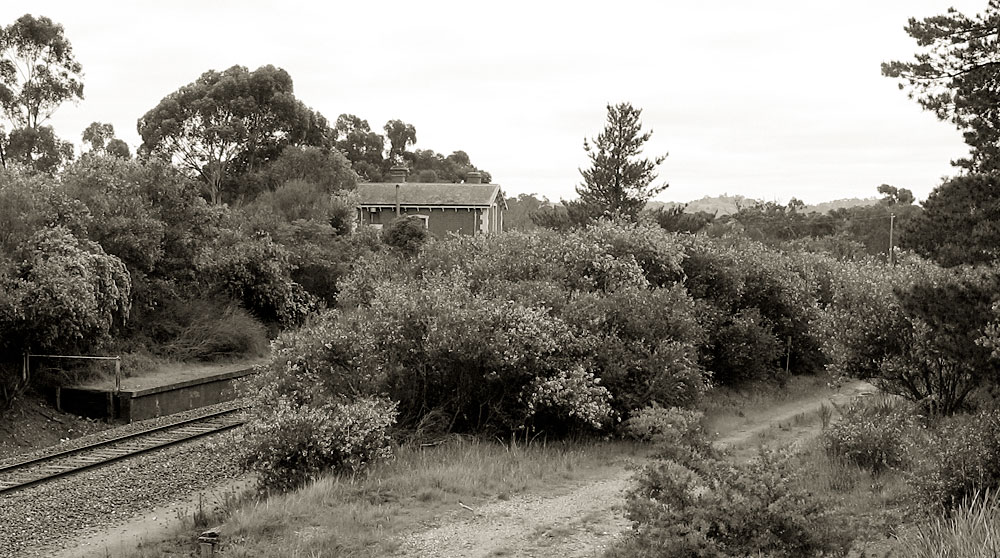
During 1845, a homestead was established by a Dr William Barker on the South bank of the creek near Porcupine Hill. Subsequently, the creek came to bear his name. Following the discovery of gold in 1851, a little to the south at Specimen Gully by employees of Dr Barker, the area was subject to a large influx of hopeful diggers. By the end of 1853, a township had been surveyed and the growing of fruit and vegetables was underway. The town was given the name Harcourt, after Sir William Vernon Harcourt who was, at the time, the Chancellor of the Exchequer under Gladstone in the British parliament.
With the building of the Melbourne, Mount Alexander & Murray River Railway through the area, which commenced in 1860, large encampments of construction workers were established at Harcourt and Porcupine Hill to the north. It was reported that during the excavation of the cutting near the station site, gold was found by several of the workmen.
On September 23 1862, a contract was signed for the construction of platforms for a passenger station at Harcourt (as well as for those at Kangaroo Flat and Chewton). This was let to George Piggins for the amount of £3,327/6/6.
On October 20 1862, the portion of the main line between Castlemaine and Sandhurst (Bendigo) was opened, but initially only for the "conveyance of passengers". It is not known to what extent the intermediate stations were serviced, but clearly, there had been a lot of temporary work undertaken on both the Geelong to Ballarat and the Woodend to Sandhurst lines. This is evidenced by a quote from a contemporary financial report: "The opening of these extensions for traffic, before the necessary station accommodation was fully completed, has been accomplished at considerable extra cost in the working expenses". At the time of the line’s official opening, only the Down track had been fully constructed, and this was operated as a single line. It was almost a year before the Up line was completed, with Double Line working commencing between Castlemaine and Sandhurst on October 1 1863.
On December 5, a contract was approved for the construction of a passenger station, goods shed, and other works at Harcourt. This was let to the firm of Dalrymple & Simmie for £4159/13/0. Subsequent details regarding this contract are still proving elusive, and a completion date for the provision of the passenger facilities is not known. It is clear, however, that the goods shed was not provided. From very early on, there was some carriage of locally quarried stone, but it was not until at least after April 1963, before general goods traffic at the station commenced. To cater for this, a single loop siding was initially installed, along with a stone faced loading platform containing a small jib crane of 1 ½ to 2 ton capacity.
Tenders were called in early 1863, for the transport of a 35 ton block of Granite from the Mt Alexander Quarries to Harcourt station, and from Spencer Street station to the Melbourne Cemetery. This was to be for the main obelisk atop a monument planned for ill-fated explorers, Burke and Wills. It took well in excess of twelve months to procure a contractor capable of the task, and to shift the monolith to the railhead. By mid-July 1864, it was in the Harcourt yard awaiting its re-location to Melbourne by special train. This movement occurred on September 5 1864, the journey taking 9 hours and ten minutes to complete.
On May 27 1885 instructions were issued for the removal of the 10 ton iron jib crane from Branxholme, and for its relocation to Harcourt. The much more diminutive crane, which had originally been installed on the goods platform, was clearly insufficient for the task of lifting the large granite blocks being transhipped here. On January 19 1887, a contract was approved for the construction of foundations for, and erection of, the crane, and was let to Newton & Bosland for £278/1/8. This replacement was mounted on a base measuring 10’ x 10’ across and 6’ 6” high (3.05m x 3.05m x 1.75m). It was of solid brick construction and was surmounted with massive granite blocks, each weighing some 2 1/2 tons. This work was completed by June 30 1887.
At around that same time, a 6 ton derrick crane was also erected nearby, possibly to handle the loading while the aforementioned work was being undertaken. Both cranes remained in use until the late 1970s, when all goods traffic from Harcourt ceased.
The Victorian Government Gazette, of February 1 1884, contained a new set of Rules for the Victorian Railways. A most notable change was the omission of all references to the 3-position semaphore signals, previously used exclusively. The only fixed signals from this date being specified as the 2-position semaphore type, that we are still familiar with to this day. Junction, Distant, Home, Starting, Advanced Starting and Siding signals are described. It is surmised that these were progressively provided as needs dictated, with it being probable that the older semaphores were used in the interim, sans the vertical position of the arm. The previous use of time interval working was also discontinued, with the telegraph now being used to ascertain if a track section was clear. By June 15 1885, Distant signals were in use at Harcourt. A protest from locomotive crews recorded on that date, complained of the unsuitable position of the Up Distant signal there. The matter was subsequently rectified shortly afterwards, with the work being completed by August 1.
The 'Winters Block' form of safeworking commenced on the Up line between Harcourt and Castlemaine on September 28 1887. This was in conjunction with the opening of Barkers Creek Siding. By March 17 1890, 'Winters Block' was in use right through Harcourt in both directions between Castlemaine and Ravenswood. (There is conjecture, however, that indicates that introduction between Castlemaine and Harcourt may have been several months later).
It’s apparent that Block working was initially introduced here without Starting signals, as on January 17 1888, the Traffic Branch made a request for one to be provided at Harcourt. On November 26 1888, new Up Starting and Up Home signals, as well as a Down Starting signal, were brought into use. On January 11 1889, the Down Distant signal was converted to a Home signal. This seemed to have been a little short-sighted at the time, being followed by a request on May 15 for the provision of a new Down Distant signal. Subsequently, on October 9 1889, a new Distant signal, as well as a new Home were brought into use.
By May 21 1894, the Station switched out each night after the passage of the last passenger train, until the first passenger train the next morning. This situation remained until March 6 1911, when it switched out after the passage of the last Up goods train on Saturday (provided the last passenger trains have passed), until the first Down train on the following Monday. For short busy periods though, such as from January 1 until February 22 1909, and from November 7 1910 until March 6 1911, it remained open continuously as a block post. With several minor variations of switching in and out times, this arrangement remained until March 28 1938, when the Block Post was switched out each night.
The double-headed rails on the main line through Harcourt were replaced with new flat-bottom rails during 1895, with the work being completed by September 12.
The full complement of non-Interlocked Up and Down Distant, Home and Starting signals was in place by July 1 1899. These were worked from quadrant levers on the Down platform, at the north end of the station office. At each end of the station, the Home and opposing Starting signal were both fitted on the same post, which was positioned on the Up side of the line. This general arrangement, with a couple of minor signal post re-locations, remained until June 30 1927, when the Down direction signals were separated onto their own posts. The Down Starting signal remained on the Up (right) side, but was moved 200 yards closer to the station, and the Down Home signal was relocated to the Down (left) side of the line, opposite the Up Starting signal. On January 25 1949, the Up Home signal was relocated to a new post, positioned 50 yards further out.
During 1901, the goods platform was extended in the Up direction, with timber facing. This work was completed on December 28. As no goods shed accommodation had been provided, on December 20, instructions were issued for an open shelter shed to be erected upon this extension, to provide some protection for the large amount of fruit that was being transhipped here. The estimated cost of construction was £40 and it included a covered verandah, which spanned the siding.
At the Down end of Harcourt station, a Public Crossing Road (PCR) was provided, which crossed the main lines and gave vehicular access to the goods yard from the west. No references to its existence are evident up to 1904, but by 1909, gates had been installed to protect it. Some discrepancy exists as to a precise location; the 1909 reference positions it very near to the end of the platform, however, subsequent plans place it some 50 yards further away. Plans were prepared in 1915 for an overbridge across the cutting at the Up end of the station to replace this crossing, but this never eventuated. It survived until September 1 1959, when a permanent closure occurred and a pedestrian crossing was substituted. This was provided with a wicket gate in the Down side boundary fence. As of February 9 2006, with the introduction of the 'Regional Fast Rail' project, the crossing was provided with pedestrian gates.
On December 23 1909, instructions were issued to extend the passenger platforms at Harcourt, and several other stations along the line. At Harcourt the additions were at the Up end. Also at around this same time, a second loop siding was constructed, with the goods platform formed into an island to service it along about 2/3 of its length. A dead-end spur was also provided at the Up end.
On November 6 1911, Co-acting arms were provided for both the Up and Down Distant signals. These arms were positioned below the existing arms on the same posts. On March 12 1926, the Co-acting arm for the Down Distant signal was abolished.
Plans were prepared in 1942 & 1948 for the provision of a signal bay attached to the station building, which was to house an interlocked lever frame. The structural work was carried out, and a tunnel under the platform was created, but the frame was never installed. The signals continued to be operated from quadrants located on the Down platform, which were moved 9 feet in the Down direction on February 22 1955, to allow for a small extension of the station office.
The Stationmaster was removed on April 10 1966, and as of April 26, the Station was worked under Caretaker conditions, being supervised by Castlemaine. From January 23 1979, it was reduced to ‘no-one-in-charge’ conditions.
On April 28 1970, the Down end crossover and the connection to the goods yard were removed. Baulks were provided at the Down end of both Goods sidings.
On April 19 1978, the station was abolished as a Double Line Block Post. All signals were also abolished and remaining points were spiked. On February 28 1979, it was officially closed to goods traffic, subsequent to the opening of the Castlemaine Freight Centre on November 7 1978. The final curtain fell on October 10 1982, when Harcourt was also closed for passenger traffic.
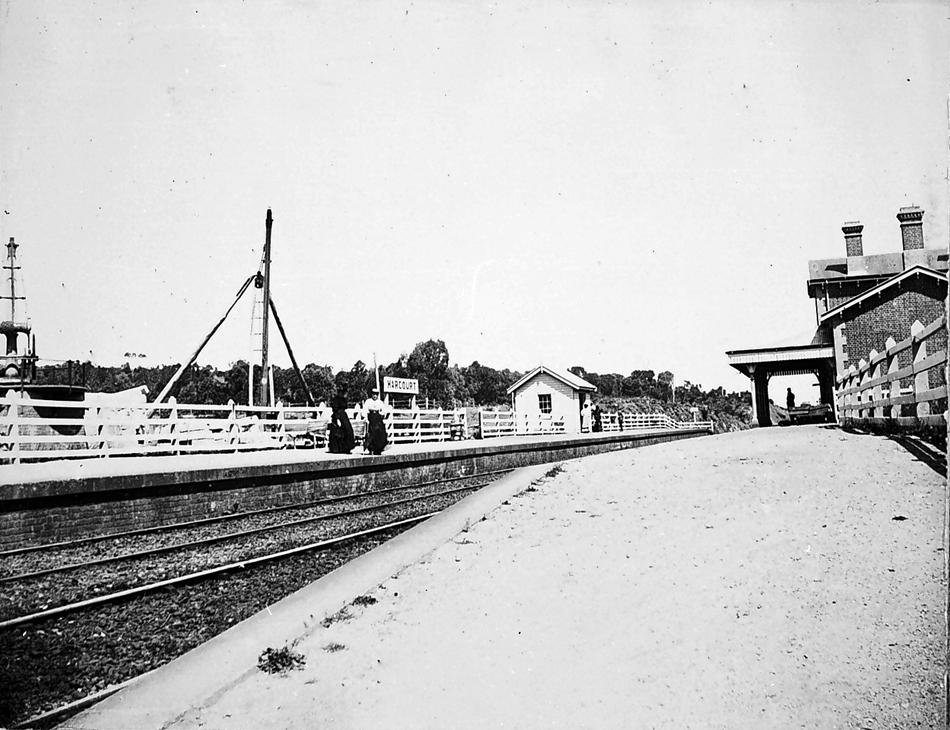
ABOVE: This photo is dated as 1894, some 32 years after the line's opening. The iron crane has been replaced with one of larger capacity, raised onto a plinth to gain extra height and a second larger timber crane has also been provided. No doubt this was to assist with the lifting of the large amount of granite blocks transhipped through here. Note the reverse colour scheme on the station sign.
(Photo courtesy of Museums Victoria).
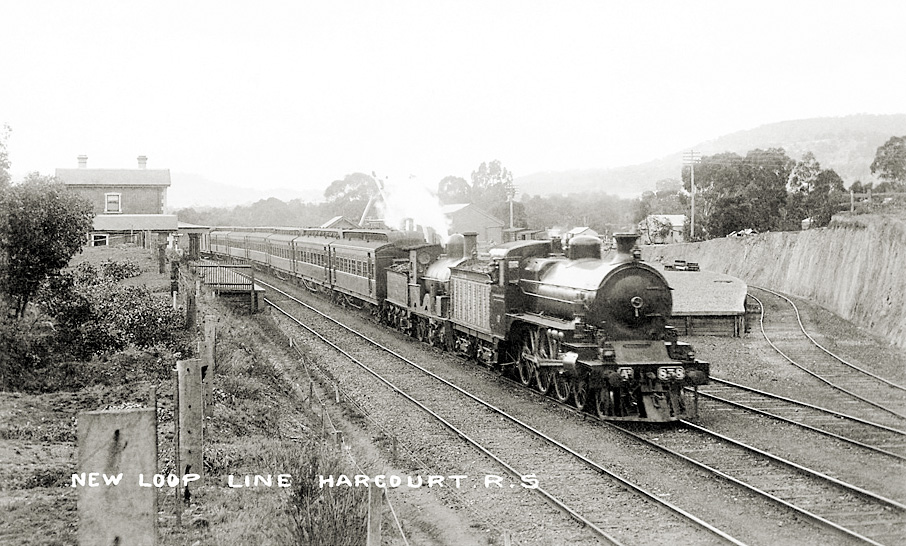
ABOVE: A very new A2 838 and an A class on a rake of "E" cars depart Harcourt on an up train c 1910. The new siding and extended island goods platform are evident. The Goods shed has now been erected and the ramps have been removed from the Up end of the platforms.
(Photo source unknown)
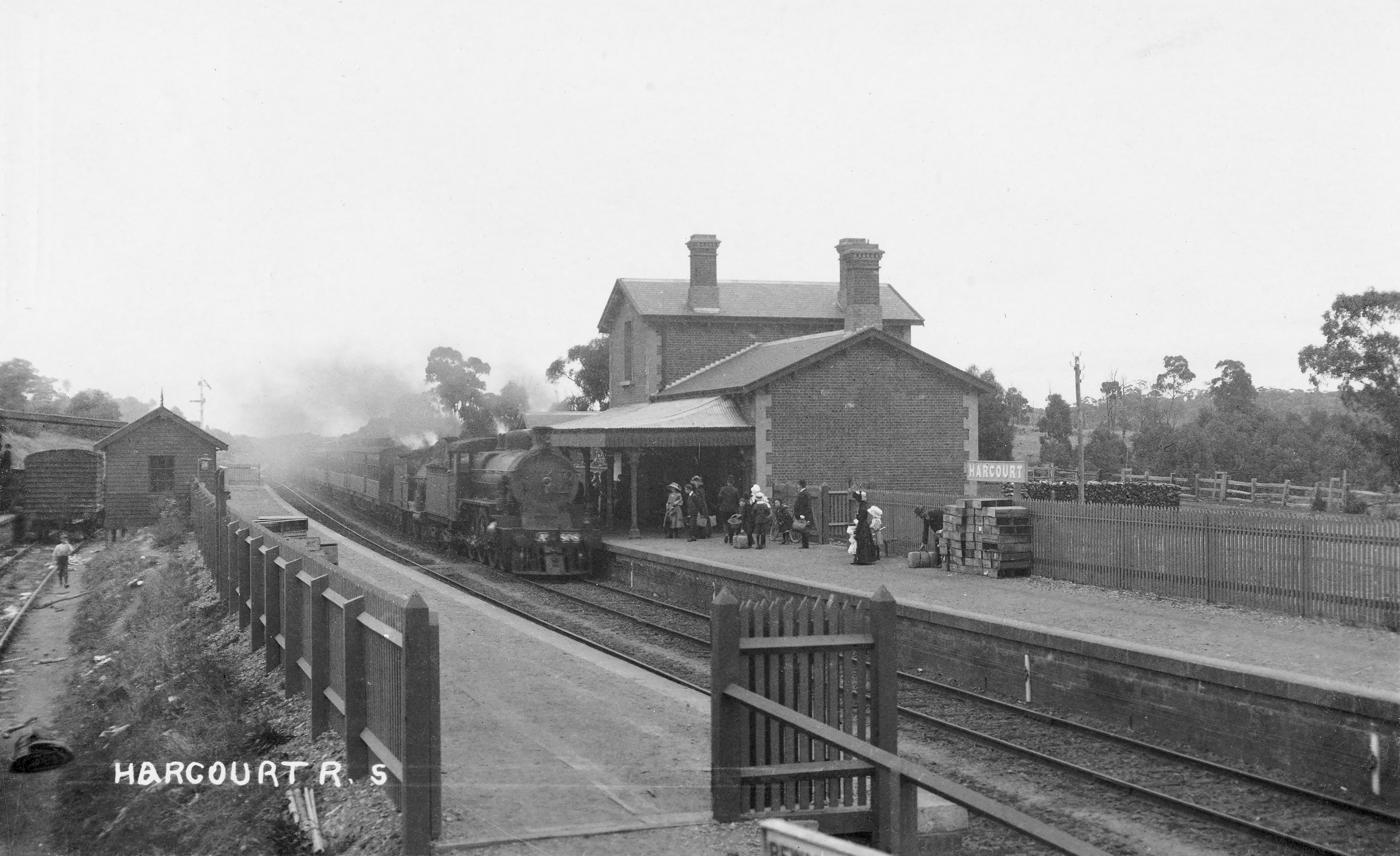
ABOVE: A fairly new A2 808 and an Old A 4-4-0 arrive Harcourt on a Down pass.
A2 808 was put into service on March 21, 1911, so the photo dates from between 1911 and 1915. By this time, the platform height had been raised.
(Photograph courtesy of SLV).
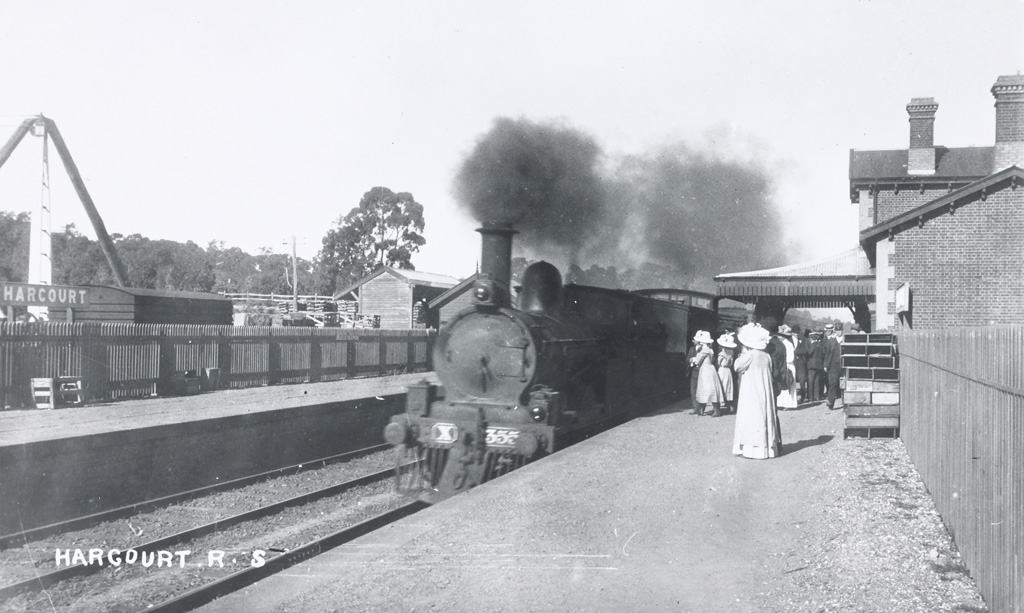
ABOVE: X 355 is arriving at Harcourt on a down Bendigo train. This appears to have been taken at a similar point in time as the previous photo, about 1911 to 1915.
(Photograph courtesy of 'Museums Victoria')
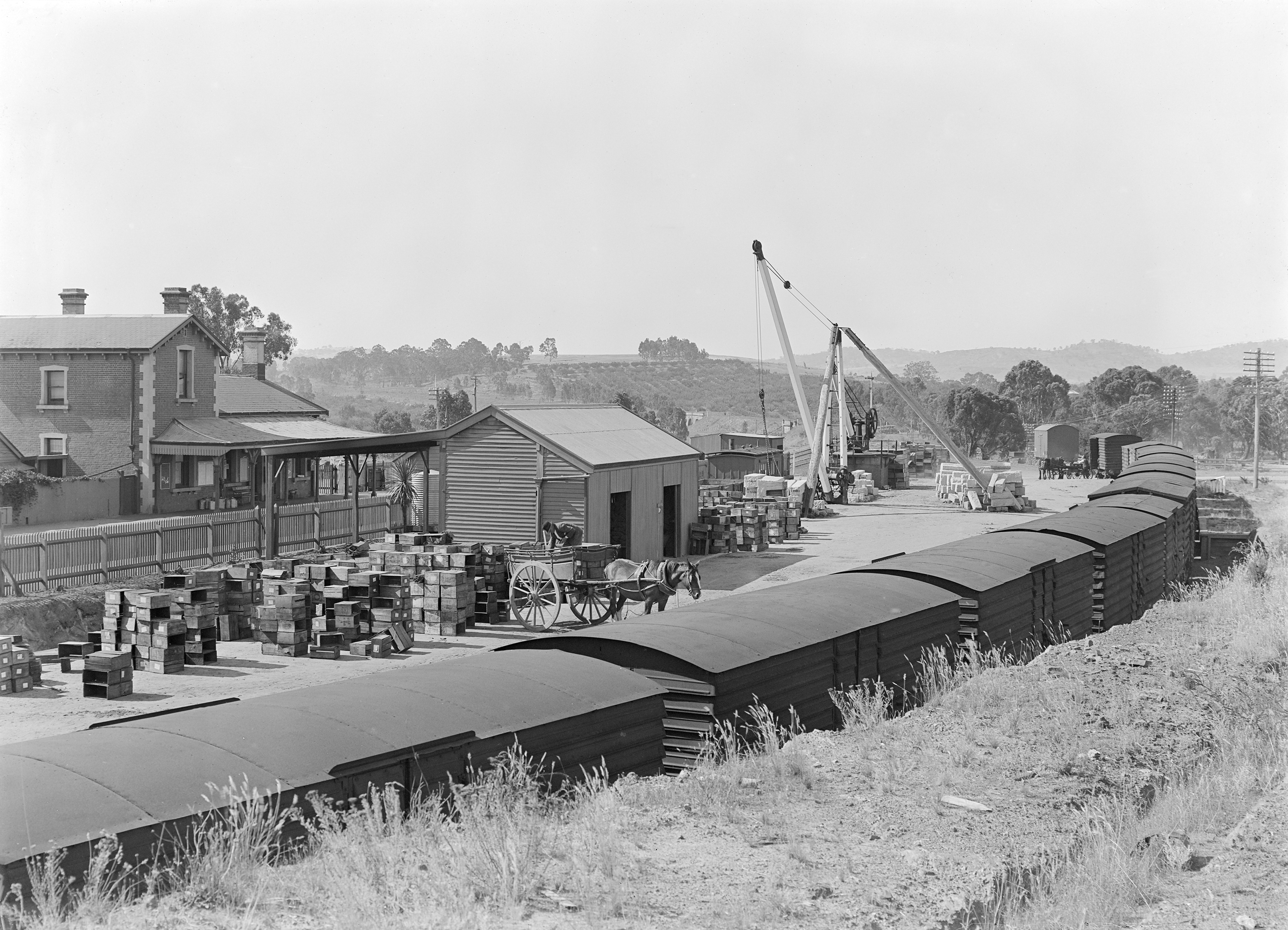
ABOVE: Harcourt generated a significant amount of goods traffic for the VR, a 1916 Argus reported 4,994 tons of fruit dispatched from Harcourt for the year ending Sept. 30 1916. In addition many of Victoria's landmark buildings including Flinders St station were built from Harcourt granite which was railed from the station. This photo, which shows a fruitgrower loading empty fruitboxes into his cart and blocks of granite awaiting loading, is a little difficult to date. It is after 1907, when construction of the longer U vans commenced, but it is difficult to tell if the signal post, seen beyond the cranes, has been relocated. This occured on January 20, 1913, with the post being moved 60 yards further out. Another clue is that the Platform verandah valence has been trimmed back, presumably due to clearance issues. It is not known however, when this had taken place.
(Photograph courtesy of SLV)
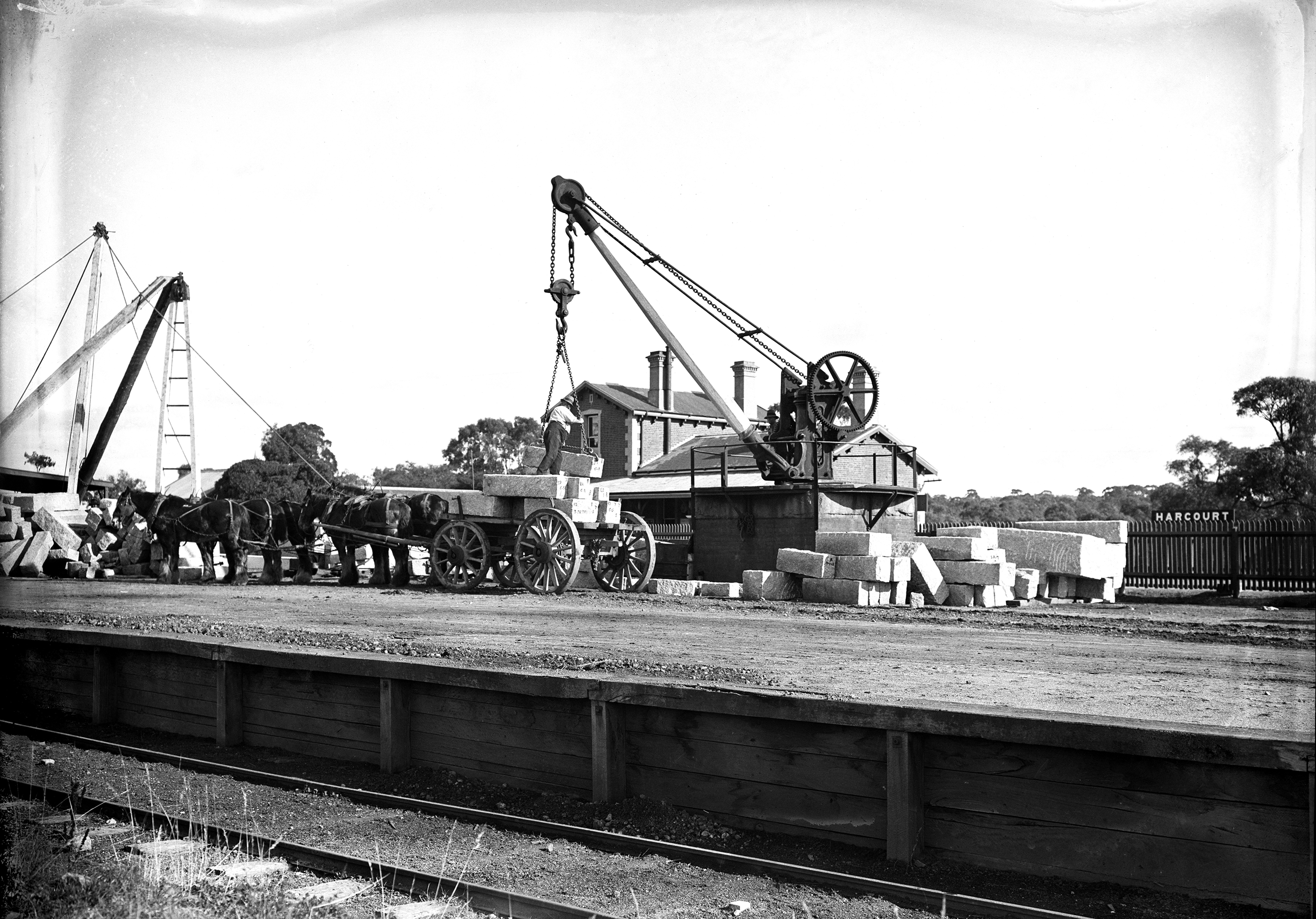
ABOVE: Unloading granite blocks for transhipment. It apppears that the timber crane is undergoing some structural work. This picture is somewhat later than the previous, with a steel flue now being evident adjacent tho the chimney on the Station building. In later years still, this was replaced with a slightly more sympathetic brick addition to the stack. Unfortunately though, when this was done, the ornate chimney cap was destroyed.
(Photograph courtesy of PROV).
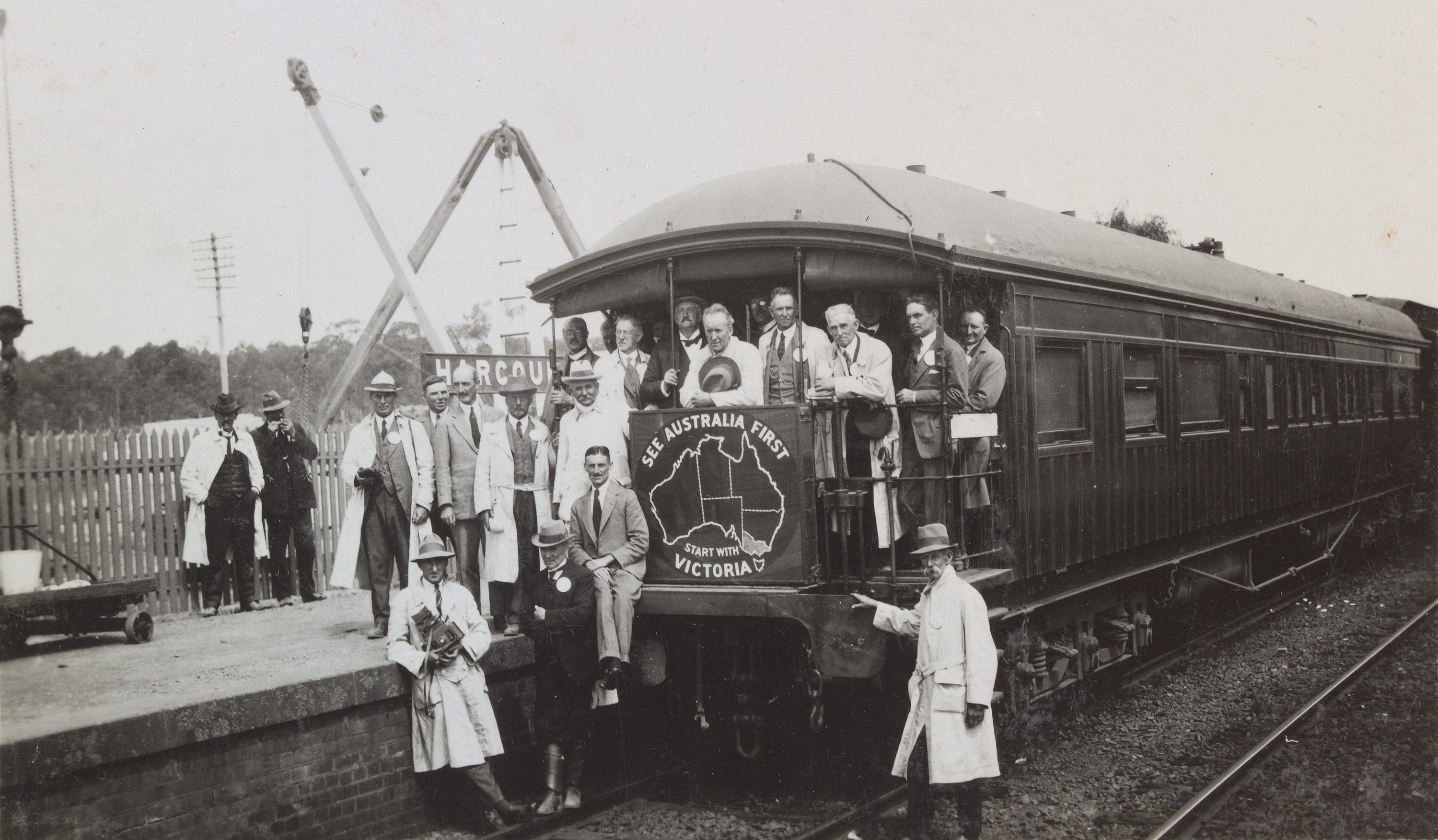
ABOVE: The third Reso Train (State Resources Train) to be run, was during March, 1923. It is shown here, paused in the Up platform at Harcourt. This train toured the agricultural districts of northern Victoria.
(Photograph courtesy of SLV).
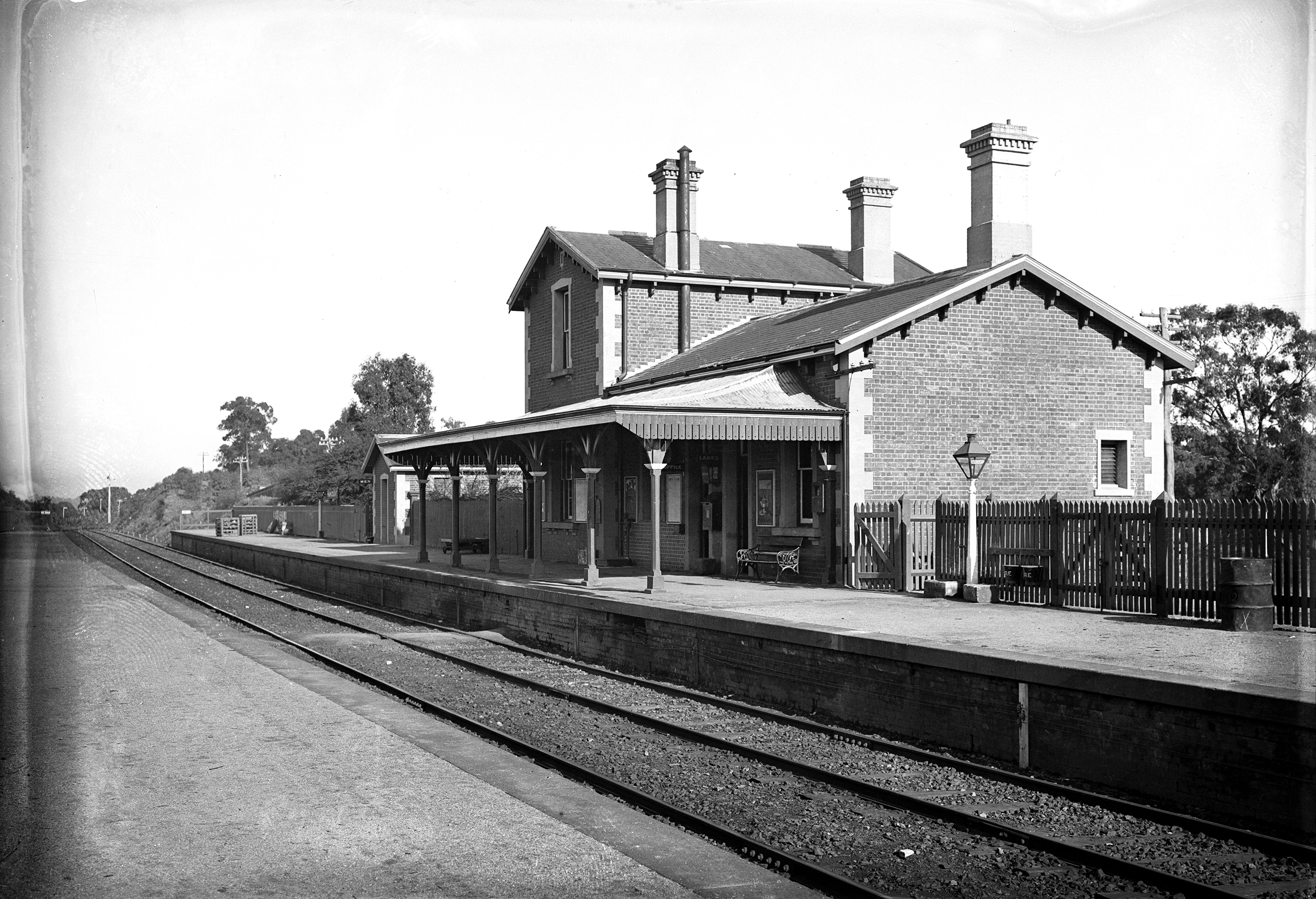
ABOVE: View of the main station building on the Down platform, looking towards Melbourne. This was taken after 1927, the year that the Down home signal, seen in the distance, was relocated to that side of the track.
(Photograph courtesy of PROV )
BELOW: Closeup of the platform lamp, note the station name on the glass.
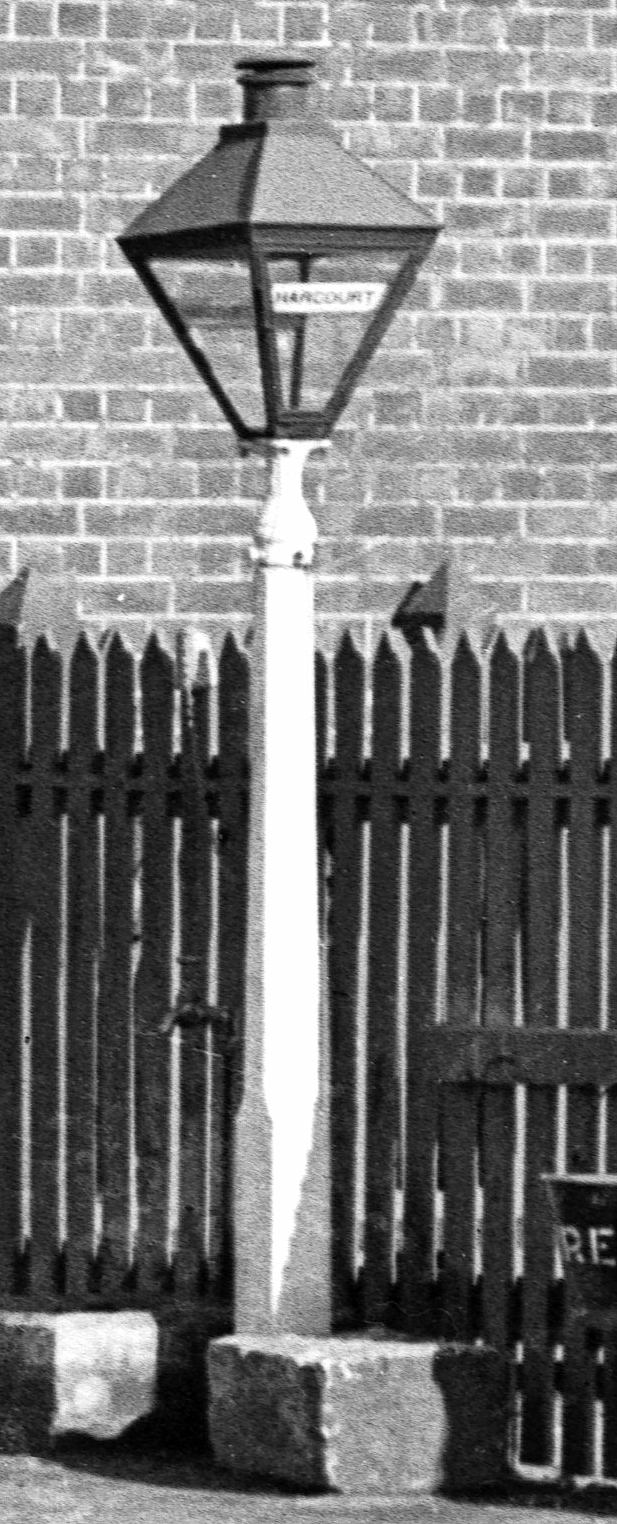
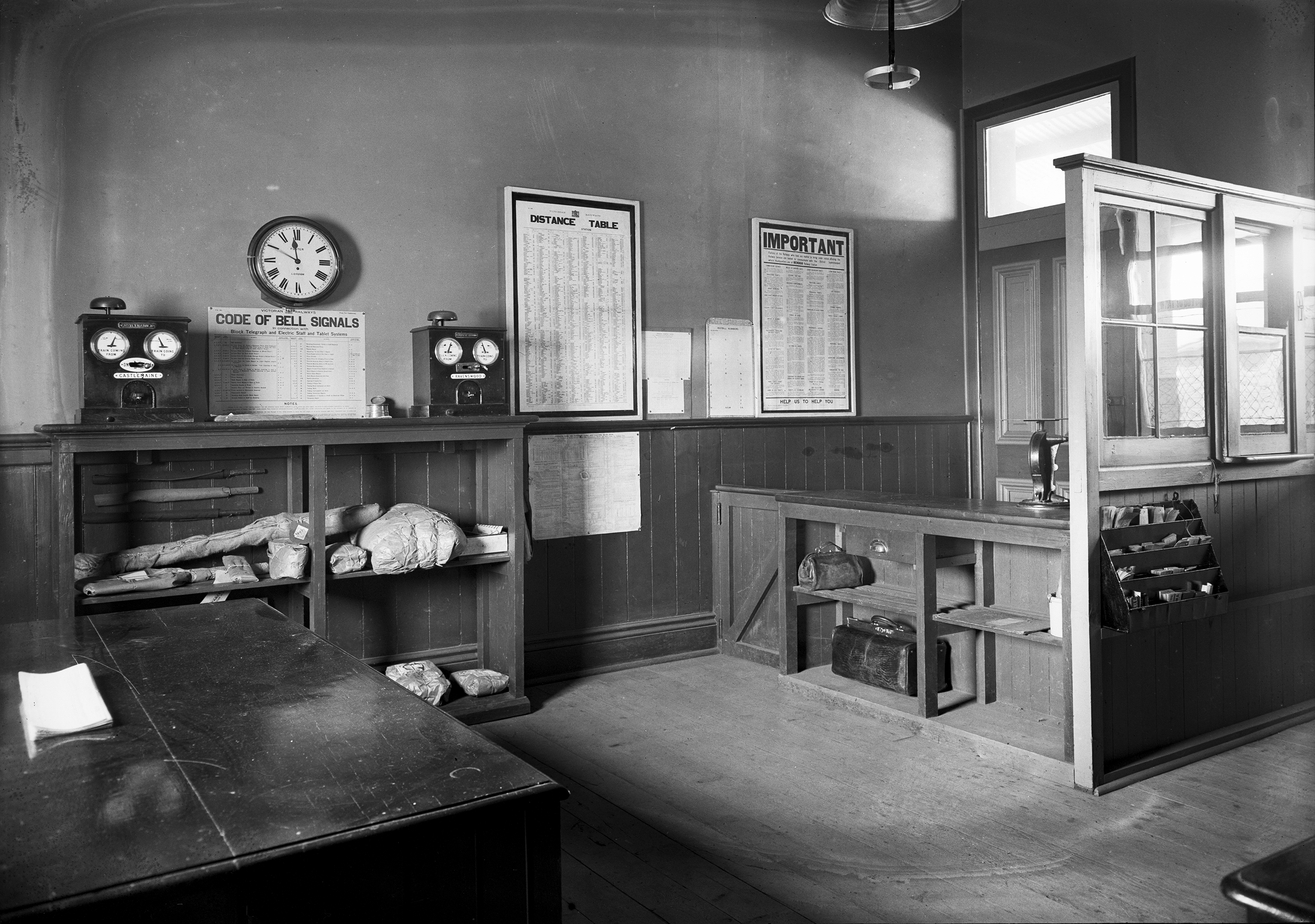
ABOVE: Harcourt parcels office circa 1930. The block instruments worked with Ravenswood and Castlemaine B.
(Photograph courtesy of PROV).
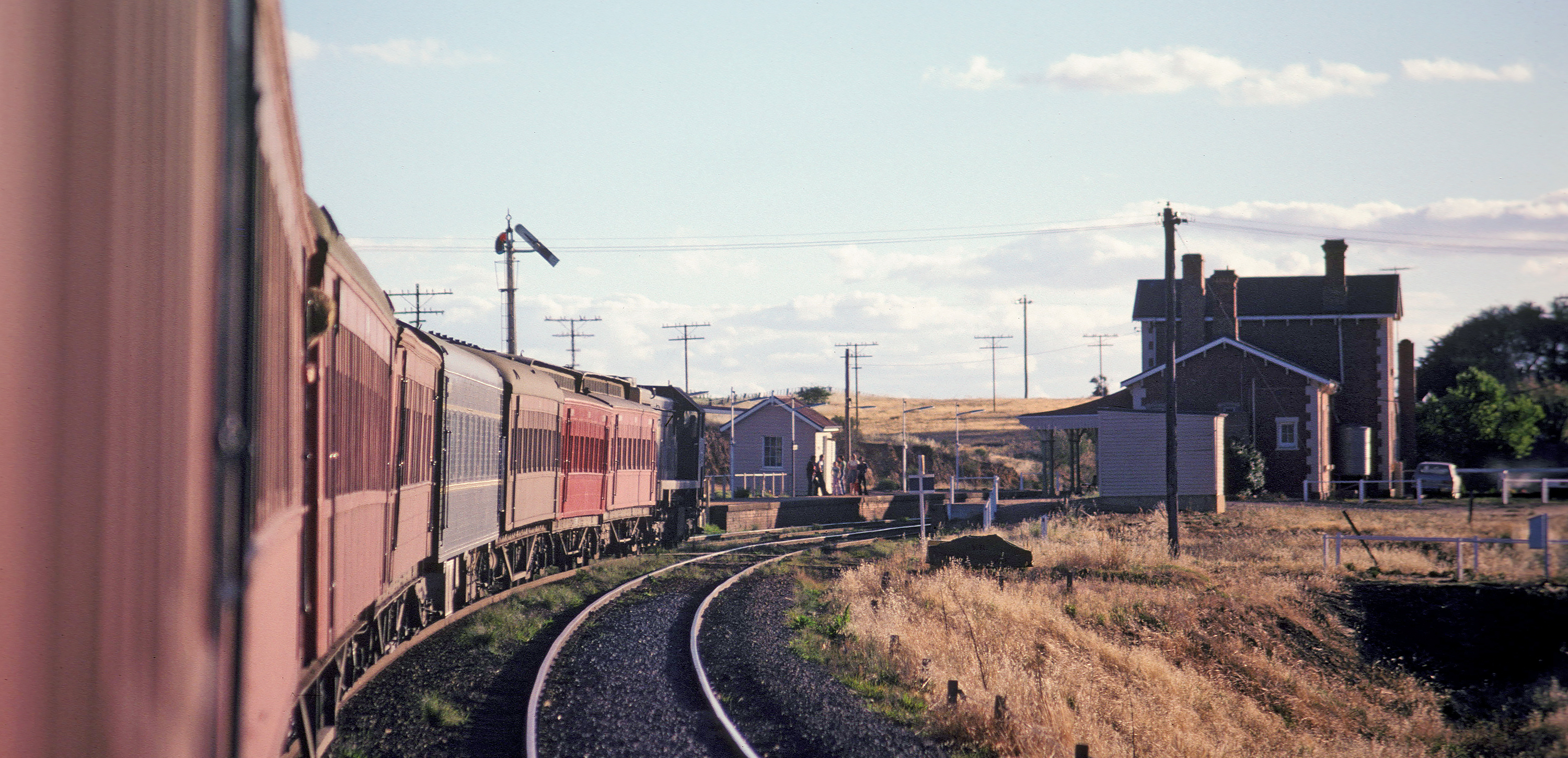
ABOVE: X 44 approaches Harcourt with an Up Sunday evening service ex Bendigo. Extra cars had been attached on this occasion, forming the return leg of an enthusiast's weekend tour. November 20, 1977.
(Photo courtesy of Geoff Winkler)

ABOVE: Extract from a 1904 VR plan.


Feel free to email me with any corrections or comments
Page modified Apr 10, 2022